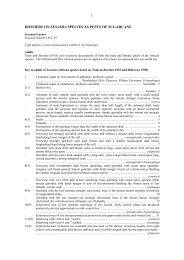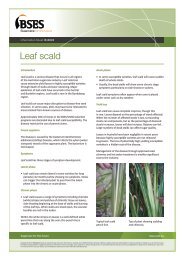Create successful ePaper yourself
Turn your PDF publications into a flip-book with our unique Google optimized e-Paper software.
MAryBOrOuGh CANe prODuCTiviTy serviCes / ANDreW DOuGALL<br />
MANAGiNG sOyBeAN sTuBBLe<br />
iN This ArTiCLe ANDreW DOuGALL, MAryBOrOuGh CANe<br />
prODuCTiviTy serviCes, OuTLiNes fOur WAys TO MAke The BesT use<br />
Of vALuABLe sOyBeAN sTuBBLe.<br />
Soybean stubble is high in nitrogen, it<br />
helps prevent soil erosion and it can<br />
inhibit weeds. Managing stubble should<br />
be on growers’ minds post-harvest. Below<br />
are some tips for gaining the most from<br />
this valuable resource.<br />
spreAD sTrAW eveNLy<br />
Check that the straw spreaders on the<br />
soybean harvester are working well.<br />
Remember that soybean crop residue is<br />
3.5% nitrogen. Therefore, if the stubble is<br />
not spread evenly, some sections of the<br />
field will end up with higher soil nitrogen<br />
than others. This will produce an uneven<br />
sugarcane crop.<br />
1 3<br />
IMAGE 1<br />
Good straw spreading is the first step.<br />
LeAve The sTuBBLe AND<br />
sTrAW ON The sOiL<br />
surfACe fOr As LONG<br />
As pOssiBLe<br />
Once soybean residue is buried, it breaks<br />
down faster and the nitrogen is released<br />
quickly. In winter, there is no crop to take<br />
up this nitrogen.<br />
2<br />
IMAGE 2<br />
Soybean stubble - its valuable! leave it<br />
on the soil surface as long as you can.<br />
Trials in Queensland showed that this<br />
nitrogen could be lost through leaching,<br />
especially if there is a lot of rain. A recently<br />
commenced project in the New South<br />
Wales sugar industry will compare stubble<br />
incorporation after soybean harvest with<br />
leaving it on the soil surface.<br />
CONsiDer MiNiMuM-TiLL<br />
CANe pLANTiNG<br />
Cane planting practices that leave the<br />
soybean stubble on the soil surface can<br />
slow the breakdown of the soybean<br />
residue over summer. This means that the<br />
nitrogen will be released slowly and taken<br />
up, as the cane needs it.<br />
IMAGE 3-4<br />
Minimum till cane planting - note the<br />
stubble retained on the soil surface.<br />
4<br />
CONTrOL WiNTer WeeDs<br />
Winter weeds in your soybean<br />
stubble can:<br />
• maintain or carry over disease<br />
• deplete soil moisture<br />
• cause problems with land preparation<br />
for cane<br />
• use the valuable nitrogen fixed by<br />
soybeans<br />
The best way to control weeds over winter<br />
is with knockdown herbicides as cultivation<br />
is not required. The fallow phase before<br />
and after soybean provides a good<br />
opportunity to treat difficult-to-control<br />
weeds such as nutgrass.<br />
TAke-hOMe MessAGe!<br />
Consider soybean stubble as a valuable<br />
asset in your farming system. By evenly<br />
spreading the straw, leaving it on the<br />
surface as long as possible, minimum<br />
till cane planting and controlling winter<br />
weeds, you can make the best use of<br />
this valuable resource.<br />
p 9 i s s u e 2 5




